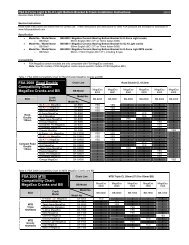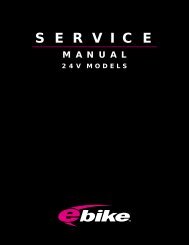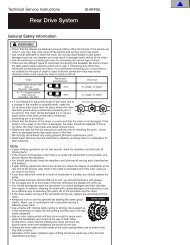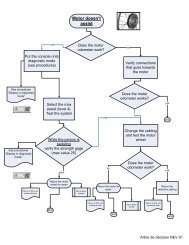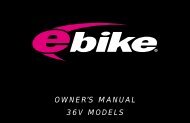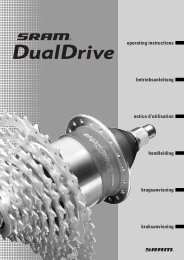Create successful ePaper yourself
Turn your PDF publications into a flip-book with our unique Google optimized e-Paper software.
OWNER’S <strong>MANUAL</strong>
1.2.3.4.5.6.7.8.9.10.11.12.13.14.15.WheelRear DerailleurChainCrank SetPedalSeat PostSaddleBolts for Bottle CageFrameHead SetHandlepostHandlebarsBrake LeverForkBrakesNOTE: This manual is not intended as a comprehensiveuse, service, repair or mainten ance manual. Please seeyour dealer for all service, repairs or maintenance.2
All folding bicycles and P.A.Q. mini-bikes areintended for use on paved roads only. P.A.Q.mountain bikes are intended for use on hardpackedtrails only, and are not intended forjumps, stunts or other extreme sports.Make sure your bicycle is used for its intendedpurpose as the misuse may lead to the failureof some component or part.Bike Fit• Is your bike the right size? If your bicycle istoo large or too small for you, you may losecontrol and fall. If your new bike is not theright size, ask your dealer to exchange itbefore you ride it.• Is the saddle at the right height? To check,see Section 3.A. If you adjust your saddleheight, follow the Minimum Insertion instructionsin Section 3.A.• Are the saddle and seat post securelyclamped? A correctly tightened saddle willallow no saddle movement in any direction.See Section 3.A.• Are the stem and handlebars at the rightheight for you? If not, see Section 3.B. Canyou comfortably operate the brakes? If not,4Firstyou may be able to adjust their angle andreach.• Do you fully understand how to operate yournew bicycle? If not, before your first ride,have your dealer explain any functions orfeatures that you do not understand.Safety First• Always wear an approved helmet when ridingyour bike, and follow the helmet manufacturer’sinstructions for fit, use and care.• Do you have all the other required andrecommended safety equipment? It’s yourresponsibility to familiarize yourself withthe laws of the area where you ride, and tocomply with all applicable laws.• Rider’s weight and luggage should not exceed105kg (230lbs).• Do you know how to correctly operate yourwheel quick releases? Check Section 4.A.1and 4.A.2 to make sure. Riding with animproperly adjusted wheel quick release cancause the wheel to wobble or disengagefrom the bicycle, and cause serious injuryor death.• Are your wheel rims clean and undamaged?Make sure the rims are clean and undamagedalong the braking surface, and checkfor excess rim wear. Periodically inspectyour rims for excessive wear and if youhave any question on whether or not yourrims are safe, have them inspected by abicycle dealer.• Handlebar and Saddle Alignment: Makesure the saddle and handlebar stem areparallel to the bike’s centerline and clampedtight enough so that you can’t twist them outof alignment.• Handlebar Ends: Make sure the handlebargrips are secure and in good condition. Ifnot, have your dealer replace them. Makesure the handlebar ends and extensionsare plugged. If not, have your dealer plugthem before you ride. If the handlebarshave bar-end extensions, make sure theyare clamped tight enough so you can’t twistthem. Please note that with the installationof some TT bars, criterium, aero bars,bar ends or a triathlon style clip-on, yourresponse time for braking and steering mayhave been adversely affected.This ManualThis manual is not intended as a comprehensiveguide to bicycling and maintenance. Itcannot teach you all the mechanical skills youneed to repair a bicycle nor can it teach you allthe skills you will need to ride a bicycle. Thismanual has a great number of tips and advicefor the specific bikes it comes with. If you areever unsure of how to maintain your bike, visita dealer and ask for advice.
The BasicsSafetyWARNING: It is your responsibility tofamiliarize yourself with the lawswhere you ride and to comply with allapplicable laws, including properlyequipping yourself and your bike as the lawrequires.Observe all local bicycle laws and regulations.Observe regulations about bicycle lighting,licensing of bicycles, riding on sidewalks, lawsregulating bike path and trail use, helmet laws,child carrier laws, and special bicycle trafficlaws. It’s your responsibility to know and obeyyour country’s laws.• Always do check the safety of your bikebefore you ride it.• Be thoroughly familiar with the controls ofyour bicycle: brakes (Section 4.B); pedals(Section G); shifting (Section 4.C).• Be careful to keep body parts and otherobjects away from the sharp teeth of chainrings, the moving chain, the turning pedalsand cranks, and the spinning wheels of yourbicycle.Riding Safety• You are sharing the road or the path withothers — motorists, pedestrians and othercyclists. Respect their rights.• Ride defensively. Always assume that othersdo not see you.• Look ahead, and be ready to avoid:»» Vehicles slowing or turning, entering theroad or your lane ahead of you, or comingup behind you.»» Parked car doors opening.»» Pedestrians stepping out.»» Children or pets playing near the road.»» Potholes, sewer grating, railroad tracks,expansion joints, road or sidewalk construction,debris and other.»» The many other hazards and distractionswhich can occur on a bicycle ride.• Ride in designated bike lanes, on designatedbike paths or as close to the edge ofthe road as possible, in the direction of thetraffic flow or as directed by local governinglaws.• Stop at stop signs and traffic lights; slowdown and look both ways at street intersections.Remember that a bicycle always losesin a collision with a motor vehicle.• Use approved hand signals for turning andstopping.• Never ride with headphones.• Never carry a passenger.• Never hitch a ride by holding on to anothervehicle.• Don’t weave through traffic or make unexpectedmoves.• Observe and yield the right of way.• Never ride your bicycle while under the influenceof alcohol or drugs.• If possible, avoid riding in bad weather,when visibility is obscured, at dawn, dusk orin the dark, or when extremely tired. Eachof these conditions increases the risk ofaccident.Wet Weather RidingWARNING: Wet weather impairstraction, braking and visibility, bothfor the bicyclist and for other vehiclessharing the road. The risk of an accident isdramatically increased in wet conditions.Under wet conditions, the stopping power ofyour brakes (as well as the brakes of other vehiclessharing the road) is dramatically reducedand your tires don’t grip nearly as well. Thismakes it harder to control speed and easier tolose control. To make sure that you can slowdown and stop safely in wet conditions, ridemore slowly and apply your brakes earlier andmore gradually than you would under normal,dry conditions. See also Section 4.B.5
Night RidingRiding a bicycle at night is many times moredangerous than riding during the day. A bicyclistis very difficult for motorists and pedestriansto see. Therefore, children should neverride at dawn, at dusk or at night. Adults whochoose to accept the greatly increased risk ofriding at dawn, at dusk or at night need to takeextra care both riding and choosing specializedequipment that helps reduce that risk.Consult your dealer about night riding safetyequipment.WARNING: Reflectors are not asubstitute for required lights. Ridingat dawn, at dusk, at night or at other timesof poor visibility without an adequatebicycle lighting system and withoutreflectors is dangerous and may result inserious injury or death.Bicycle reflectors are designed to pick up andreflect car lights and streetlights in a way thatmay help you to be seen and recognized as amoving bicyclist.CAUTION: Check reflectors and theirmounting brackets regularly to makesure that they are clean, straight, unbrokenand securely mounted. Have your dealerreplace damaged reflectors and straightenor tighten any that are bent or loose.If you choose to ride under conditions of poorvisibility, check and be sure you comply withall local laws about night riding, and take the6following strongly recommended additionalprecautions:• Purchase and install a generator or batterypowered head and taillight that meet alllocal regulatory requirements and provideadequate visibility.• Wear light-colored, reflective clothing andaccessories, such as a reflective vest, reflectivearm and leg bands, reflective stripeson your helmet, flashing lights attached toyour body and/or your bicycle.• Make sure your clothing or anything youmay be carrying on the bicycle does notobstruct a reflector or light and securelymounted reflectors.• Make sure that your bicycle is equipped correctlywith reflectors.While riding at dawn, at dusk or at night:• Ride slowly.• Avoid dark areas and areas of heavy or fastmovingtraffic.• Avoid road hazards.If riding in traffic:• Be predictable. Ride so that drivers can seeyou and predict your movements.• Be alert. Ride defensively and expect theunexpected.• Ask your dealer about traffic safety classesor a good book on bicycle traffic safety.
FitSaddle PositionCorrect saddle adjustment is an important factorin getting the most performance and comfortfrom your bicycle. If the saddle position is notcomfortable for you, see your dealer.The saddle can be adjusted in three directions:• Up and down adjustment. To check for correctsaddle height:»» Sit on the saddle.»» Place one heel on a pedal.»» Rotate the crank until the pedal with yourheel on it is in the down position and thecrank arm is parallel to the seat tube.If your leg is not completely straight, yoursaddle height needs to be adjusted. If yourhips must rock for the heel to reach thepedal, the saddle is too high. If your leg isbent at the knee with your heel on the pedal,the saddle is too low.Once the saddle is at the correct height,make sure that the seat post does notproject from the frame beyond its “MinimumInsertion” or “Maximum Extension” mark.WARNING: If your seat post projectsfrom the frame beyond the MinimumInsertion or Maximum Extension mark, theseat post may break, which could causeyou to lose control and fall.• Front and back adjustment. The saddle canbe adjusted forward or backward to helpyou get the optimal position on the bike.Ask your dealer to set the saddle for youroptimal riding.• Saddle angle adjustment. Most peopleprefer a horizontal saddle; but some riderslike the saddle nose angled up or down justa little. Your dealer can adjust the saddleangle.NOTE: If your bicycle has a suspension seatpost, periodically ask your dealer to check it.Small changes in saddle position can have asubstantial effect on performance and comfort.To find your best saddle position, make onlyone adjustment at a time.WARNING: After any saddle adjustment,be sure that the saddleadjusting mechanism is properly tightenedbefore riding. A loose saddle clamp or seatpost binder can cause damage to the seatpost, or can cause you to lose control andfall. A correctly tightened saddle adjustingmechanism will allow no saddle movementin any direction. Periodically check to makesure that the saddle adjusting mechanism isproperly tightened.Handlebar Height and AngleWARNING: The stem’s MinimumInsertion Mark must not be visibleabove the top of the headset. If the stem isextended beyond the Minimum InsertionMark, the stem may break or damage thefork’s steerer tube, which could cause youto lose control and fall.Your dealer can also change the angle of thehandlebar or bar-end extensions.WARNING: An insufficiently tightenedstem binder bolt, handlebar binderbolt or bar-end extension clamping bolt maycompromise steering action, which couldcause you to lose control and fall. Place thefront wheel of the bicycle between your legsand attempt to twist the handlebar/stemassembly. If you can twist the stem inrelation to the front wheel, turn the handlebarsin relation to the stem, or turn thebar-end extensions in relation to thehandlebar, the bolts are insufficientlytightened.7
WheelsInstalling a Quick Release Front WheelCAUTION: If your bike is equippedwith disk brakes, be careful not todamage the disk, caliper or brake padswhen re-inserting the disk into the caliper.Never activate a disk brake’s control leverunless the disk is correctly inserted in thecaliper. See also Section 4.B.• Move the quick-release lever so that itcurves away from the wheel. This is theOPEN position.• With the steering fork facing forward, insertthe wheel between the fork blades so thatthe axle seats firmly at the top of the slotsthat are at the tips of the fork blades —the fork dropouts. The quick-release levershould be on the left side of the bicycle.• Holding the quick-release lever in the OPENposition with your right hand, tighten thetension-adjusting nut with your left hand untilit is tight against the fork dropout.• While pushing the wheel firmly to the topof the slots in the fork dropouts, and at thesame time centering the wheel rim in thefork, move the quick-release lever upwardsand swing it into the CLOSED position.8TechThe lever should now be parallel to the forkblade and curved toward the wheel. Withthe right amount of force, the lever shouldmake a clear embossed mark on the surfaceof the fork.WARNING: Securely clamping thefront and rear wheels takes considerableforce. If you can fully close the quickrelease without wrapping your fingersaround the fork blade for leverage, and thelever does not leave a clear embossed markin the surface of your fork, the tension isinsufficient. Open the lever; turn thetension-adjusting nut clockwise a quarterturn; then try again.• If the lever cannot be pushed all the way toa position parallel to the fork blade, returnthe lever to the OPEN position. Then turnthe tension-adjusting nut counterclockwiseone-quarter turn and try tightening the leveragain.• Re-engage the brake quick-release mechanismto restore correct brake pad-to-rimclearance; spin the wheel to make sure thatit is centered in the frame and clears thebrake pads; then squeeze the brake leversand make sure that they work.Installing a Quick Release Rear Wheel• Make sure that the rear derailleur is still inits outermost, high-gear position.• Pull the derailleur body back with your righthand.• Move the quick-release lever to the OPENposition. The lever should be on the side ofthe wheel opposite the derailleur and freewheelsprockets.• Put the chain on top of the smallest freewheelsprocket. Then, insert the wheel upand back into the frame dropouts and pull itall the way in to the dropouts.• Tighten the quick-release adjusting nut untilit is finger tight against the frame dropout;then swing the lever toward the front of thebike until it is parallel to the frame’s chainstay or seat stay and is curved toward thewheel. To apply enough clamping force, youshould have to wrap your fingers arounda frame tube for leverage, and the levershould leave a clear embossed mark in thesurface of your frame.
Brakes – Rim Brakes & DiscBrakesRiding with improperly adjusted brakes or wornbrake pads is dangerous and can result in seriousinjury or death.Applying brakes too hard or too suddenly canlock up a wheel, which could cause you to losecontrol and fall. Sudden or excessive applicationof the front brake may pitch the rider overthe handlebars, which may result in injury ordeath.Some bicycle brakes, such as disc brakes andlinear-pull brakes, are extremely powerful. Exerciseparticular care when using them.Disc brakes can get extremely hot with extendeduse. Be careful not to touch a disc brakeuntil it has had plenty of time to cool.See the manufacturer’s instructions for operationand care of your brakes. If you do not havemanufacturer instructions, call your dealer orthe brake manufacturer.Brake Controls and FeaturesIt’s very important to learn and rememberwhich brake lever controls what brake. Yourbike will come already set and adjusted so thatthe right brake lever controls the rear brake.The left lever controls the front brake. Makesure your hands can reach and squeeze thebrake levers.NOTE: In the UK and Japan, the right levercontrols the front brake while the left levercontrols the rear brake. All brakes should beadjusted according to local regulations.How Brakes WorkThe action of a rim-actuated brake on a bicycleis a function of the friction between thebrake surfaces — usually the brake pads andthe wheel rim. To make sure that you havemaximum friction available, keep your wheelrims and brake pads clean and free of dirt,lubricants, waxes or polishes. Another importantbicycle brake is a disc brake. To installdisc brakes, special disc brake mounts on theframe and fork and special hubs are necessary.These brakes are small and rely on brake padsthat squeeze both sides of a small disc rotorthat is mounted on each wheel. Disc brakesare quite resistant to weather and provide verystrong stopping power on steep hills or on wetterrain and are well suited for heavy riders.Brakes are designed to control your speed, notjust to stop the bike. Maximum braking force foreach wheel occurs at the point just before thewheel “locks up” (stops rotating) and starts toskid. Once the tire skids, you actually lose mostof your stopping force and completely losedirectional control.NOTE: Make sure that no oil or lubricationtouches your brake pads or the bicycles rims’braking surfaces. Please replace worn brakeshoes only with factory authorized brakereplacements.9
Shifting GearsYour multi-speed bicycle will have a derailleurdrive train, an internal gear hub drive train or, insome special cases, a combination of the two.How a Derailleur Drive Train WorksIf your bicycle has a derailleur drive train, thegear-changing mechanism will have:»» A rear cassette or freewheel sprocketcluster.»» A rear derailleur.»» Usually a front derailleur.»» One or two shifters.»» One, two or three front sprockets calledchain rings.»» A drive chain.Shifting GearsThere are several different types and styles ofshifting controls: levers, twist grips, triggers,combination shift/brake controls and pushbuttons. Ask your dealer to explain the type ofshifting controls that are on your bike, and toshow you how they work.A downshift is a shift to a “lower” or “slower”gear, one that is easier to pedal. An upshift isa shift to a “higher” or “faster”, harder to pedalgear. To select a gear that will make pedaling10easier on a hill, make a downshift in one of twoways: shift the chain down (the gear “steps” toa smaller gear at the front) or shift the chain up(the gear “steps” to a larger gear at the rear.)So, at the rear gear cluster, what is called adownshift actually moves the chain up to alarger gear. The way to keep things straight isto remember that shifting the chain in towardsthe centerline of the bike is for accelerating andclimbing and is called a downshift. Moving thechain out or away from the centerline of thebike is for speed and is called an upshift.Whether upshifting or downshifting, the bicyclederailleur system design requires that the drivechain be moving forward and be under at leastsome tension. A derailleur will shift only if youare pedaling forward.Shifting the Rear DerailleurThe right shifter controls the rear derailleur.The function of the rear derailleur is to movethe drive chain from one gear sprocket to another.The smaller sprockets on the rear wheelgear cluster produce higher gear ratios. Pedalingin the higher gears requires greater pedalingeffort, but takes you a greater distance witheach revolution of the pedal cranks. The largersprockets produce lower gear ratios. Usingthem requires less pedaling effort, but takesyou a shorter distance with each pedal crankrevolution. There are two set screws or limitscrews on the rear derailleur body that limit thetravel of the rear derailleur. Tightening the rearderailleur high gear adjustment screw keepsthe chain from shifting off the small (high) gearthat is on the rear axle. Tightening the rearderailleur low gear adjustment screw keeps thechain from shifting off the large (low) gear intothe rear wheel. Moving the chain from a smallersprocket of the gear cluster to a larger sprocketresults in a downshift. Moving the chain fromthe smaller sprocket on the chain rings to alarger sprocket results in what is called an“upshift.” In order for the derailleur to move thechain from one sprocket to another, the ridermust be pedaling forward.Shifting the Front DerailleurThe front derailleur, which is controlled by theleft shifter, shifts the chain between the largerand smaller chain rings. Shifting the chain ontoa smaller chain ring makes pedaling easier (adownshift). Shifting to a larger chain ring makespedaling harder (an upshift). There are 2 (two)adjustment screws on the front derailleur: oneis to limit the travel of the front derailleur sothat the chain can be shifted upwards towardsthe larger, higher or harder to pedal gears butwill not allow the chain to “overshift.” The otherscrew limits the travel of the front derailleurtowards the smaller or easier-to-pedal chainwheel.By limiting travel, it prevents the chainfrom “undershifting” and keeps the chain fromfalling off the chainwheel onto the frame.
WARNING: Never shift a derailleuronto the largest or the smallestsprocket if the derailleur is not shiftingsmoothly. The derailleur may be out ofadjustment and the chain could jam,causing you to lose control and fall.Which Gear Should I Be In?The combination of largest rear and smallestfront gears is for the steepest hills. The smallestrear and largest front combination is forthe greatest speed. It is not necessary to shiftgears in sequence. Instead, find the “startinggear” which is right for your level of ability — agear which is hard enough for quick accelerationbut easy enough to let you start from astop without wobbling — and experiment withupshifting and downshifting to get a feel for thedifferent gear combinations. At first, practiceshifting where there are no obstacles, hazardsor other traffic, until you’ve built up your confidence.Learn to anticipate the need to shift,and shift to a lower gear before the hill gets toosteep. If you have difficulties with shifting, theproblem could be mechanical adjustment. Seeyour dealer for help.How an Internal Gear HubDrive Train WorksIf your bicycle has an internal gear hub drivetrain, the gear changing mechanism will consistof:»» A 3, 5, 7, 8 or possibly 12-speed internalgear hub.»» One, or sometimes two shifters.»» One or two control cables.»» One front sprocket called a chain ring.»» A drive chain.Shifting Internal Gear Hub GearsShifting with an internal gear hub drive trainis simply a matter of moving the shifter to theindicated position for the desired gear. Afteryou have moved the shifter to the gear positionof your choice, ease the pressure on the pedalsfor an instant to allow the hub to completethe shift.Which Gear Should I Be In?The numerically lowest gear (1) is for thesteepest hills. The numerically largest gear (3,5, 7 or 12, depending on the number of speedsof your hub) is for the greatest speed.11
ChainsSingle-speed and three-speed bicycles as wellas many IGH (Internal Geared Hubs) equippedbicycles use a “1/2 x 1/8” chain that has amaster link.To reinstall the “1/2 x 1/8” chain, turn the bicycleupside down, and after reinstalling thechain, pull the rear wheel axle in a rearwarddirection. With rotation of the chain, any “tightspot” and a “loose spot” are due to inconsistentchain wheel roundness. Adjust the chain sothere is no looseness when the chain is in oneof its “tight spots.”Derailleur equipped bicycles use a narrower“1/2 x 3/32” chain that has no master link. Witha “1/2 x 3/32” chain, it is necessary most of thetime to use a special tool to push a link pin outof a chain to separate and remove it. There aremany methods of measuring the chain to determineif it is too worn. There are some excellentchain wear indicators for sale at bike shops.Since the chain rotates a lot more on the rearwheel than the front, please note that replacingany already badly worn chain may mean thatyou might also need to replace the rear wheelcassette or freewheel as well.Pedals• Toe clips and straps are a means to keepyour feet correctly positioned and engagedwith the pedals. The toe clip positions theball of the foot over the pedal spindle,which gives maximum pedaling power. Thetoe strap, when tightened, keeps the footengaged throughout the rotation cycle ofthe pedal. Toe clips and straps work mosteffectively with cycling shoes designed foruse with toe clips. Care should be taken tobecome accustomed to the use of toe clipsbefore riding in traffic.• Clipless pedals (sometimes called “step-inpedals”) are another means to keep feetsecurely in the correct position for maximumpedaling efficiency. They have a plate,called a “cleat,” on the sole of the shoe,which clicks into a mating spring-loaded fixtureon the pedal. They only engage or disengagewith a very specific motion that mustbe practiced until it becomes instinctive.12
Transporting Your BikeAll 16- and 20-inch wheeled folding bicyclescan be transported by the methods describedin sections a, b, c, and d below. Bikes with24- and 26-inch wheels, as well as road bikeswith 700c wheels, have limited carrying abilityand will not fit in public conveyance overheadcompartments. Of course, using the methodsdescribed in sections c and d below are noproblem. Our suggestion for commuting andmedium distance travel is that it is best to usea nylon bag carry bag. For long distance travel,the 24- and 26-inch wheeled bikes, and 700croad bicycles, should be packed in a sturdytravel case.RollingA much easier and more efficient methodto transport your 16 to 20-inch wheeledbicycles is to roll them on their wheels. Rememberthat the Jetstream fork and framemust be bound together so the wheels willroll. Raise the folded bikes seatpost andsaddle approximately 305 mm (12 inches)and tilt or angle the folded bike towards you.Then simply push the bicycle forward. Thisconveyance method is perfect for travelfrom parking lots to a bus, train or airplaneterminal and transition from rough tarmac ordriveways to smooth granite or tile floors.Travel CaseA semi-hard travel case is a perfect longdistance transportation solution for manyfolding bicycles. They work well on any publictransportation system. Many travel casesare safe enough to withstand the mostdifficult luggage safety challenge, which ischecking luggage in at the airport. You canfind travel cases large enough for most 16-,20-, and 24-inch wheeled bicycles. However,when carrying bikes with 26-inch wheels,the wheels must be removed.CarryingCarrying a 16- to 20-inch wheeled foldedbicycle is quite easy for extra short to mediumdistances. For Jetstream full suspensionbicycles, make sure you have the blacknylon strap that came with your bike to bindthe wheels together. Simply grab the bicycleand carry by the saddles edge. When crossinga threshold, boarding a bus, train orairplane or stowing the bike in an overheadcompartment, you will need to pick your bicycleup. When the occasion arises that youneed to travel or commute and want yourbicycle with you, feel confident knowing yourbike is ready when you are.BagThis is a clean and efficient method of packingand carrying any of the many Dahonbicycles. Simply place the folded, collapsedor packed-away bicycle on the opened bagthat is lying on the floor. There are spaciousinternal pockets for any parts that must beremoved such as pedals and any tools thatyou might need later. A nice neat package isvisible when the sides of the bag are pulledup tight and the handle/shoulder strap isfastened. The entire operation takes only afew seconds. It is perfect to carry your bikeon any sort of public conveyance or to carryin a car. However, the bag is not approvedfor airline check in.13
ServiceWARNING: Technological advanceshave made bicycles and bicyclecomponents more complex, and the pace ofinnovation is increasing. It is impossible forthis manual to provide all the informationrequired to properly repair and/or maintainyour bicycle. In order to help minimize thechances of an accident and possible injury,it is critical that you have any repair ormaintenance that is not specificallydescribed in this manual performed by yourdealer. Equally important is that yourindividual maintenance requirements will bedetermined by everything from your ridingstyle to geographic location. Consult yourdealer for help in determining your maintenancerequirements.WARNING: Many bicycle service andrepair tasks require special knowledgeand tools. Do not begin any adjustmentsor service on your bicycle until youhave learned from your dealer how toproperly complete them. Improper adjustmentor service may result in damage to thebicycle or in an accident that can causeserious injury or death.Service IntervalsSome service and maintenance can and shouldbe performed by the owner, and requires nospecial tools or knowledge beyond what is presentedin this manual.The following are examples of the type ofservice you should perform yourself. All otherservice, maintenance and repair should be performedin a properly equipped facility by a qualifiedbicycle mechanic, using the correct toolsand procedures specified by the manufacturer.Break-in PeriodYour bike will last longer and work better ifyou break it in before riding it hard. Controlcables and wheel spokes may stretch or “seat”when a new bike is first used and may requirereadjustment by your dealer. Your MechanicalSafety Check will help you identify some thingsthat need readjustment. But even if everythingseems fine to you, it is best to take yourbike back to the dealer for a checkup. Dealerstypically suggest you bring the bike in for a30-day checkup. Another way to judge when itis time for the first checkup is to bring the bikein after three to five hours of hard off-road use,or about 10 to 15 hours of on-road or morecasual off-road use. But if you think somethingis wrong with the bike, take it to your dealerbefore riding it again.After Every Long or Hard RideIf the bike has been exposed to water or grit,or at least every 100 miles, clean it by wiping itclean and lightly oil the chain with a dry Teflonlubrication or a synthetic based chain lube.Then, very importantly, wipe off excess oil.Long lasting lubrication is a function of climate.(Hot or cold, wet or dry.) For general cyclelubrication, Dahon suggests using lightweightmineral based oil that is commonly availablein most bike shops or hardware stores. If youhave any questions, please talk to your dealeras an incorrect lubricant can damage thepainted surfaces.After Every Long or Hard Ride or AfterEvery 10 to 20 Hours of RidingSqueeze the front brake and rock the bikeforward and back. If you feel a clunk with eachforward or backward movement of the bike,you probably have a loose headset. Have yourdealer check it.Lift the front wheel off the ground and swingit from side to side. If you feel any binding orroughness in the steering, you may have a tightheadset. Have your dealer check it.Grab one pedal and rock it toward and awayfrom the centerline of the bike; then do thesame with the other pedal. Anything feel loose?If so, have your dealer check it.14
Take a look at the brake pads. Starting to lookworn or not hitting the wheel rim squarely?Time to have the dealer adjust or replace them.Carefully check the control cables and cablehousings. Any rust? Kinks? Fraying? If so, haveyour dealer replace them.Squeeze each adjoining pair of spokes oneither side of each wheel between your thumband index finger. Do they all feel about thesame? If any feel loose, have your dealercheck the wheel.Check to make sure that all parts and accessoriesare still secure, and tighten any that arenot. When replacement parts are necessary,be sure to use factory authorized replacementparts from your local authorized Dahon dealer.WARNING: Like any mechanicaldevice, a bicycle and its componentsare subject to wear and stress. Differentmaterials and mechanisms wear or fatiguefrom stress at different rates and havedifferent life cycles. If a component’s lifecycle is exceeded, the component cansuddenly and catastrophically fail, causingserious injury or death to the rider. Scratches,cracks, fraying and discoloration aresigns of stress-caused fatigue and indicatethat a part is at the end of its useful life andneeds to be replaced. While the materialsand workmanship of your bicycle or ofindividual components may be covered by awarranty for a specified period of time bythe manufacturer, this is no guarantee thatthe product will last the term of thewarranty. Product life is often related to thekind of riding you do and to the treatment towhich you submit the bicycle. The bicycle’swarranty is not meant to suggest that thebicycle cannot be broken or will last forever.It only means that the bicycle is coveredsubject to the terms of the warranty.Check the frame, particularly in the areaaround all tube joints; the handlebars; thestem; and the seatpost for any deep scratches,cracks or discoloration. These are signs ofstress-caused fatigue and indicate that a partis at the end of its useful life and needs to bereplaced.15
WarrantyDahon Five-Year LimitedWarrantyDahon warrants its bicycle frames, handleposts,and rigid forks to be free from defects inmaterials and workmanship for a period of fiveyears. In addition, Dahon warrants all originalparts on the bicycle, excluding suspensionforks and rear shocks, for a period of one yearfrom the date of purchase. Suspension forksand rear shocks shall be covered by the warrantyof their original manufacturers.This warranty is limited to the repair or replacementof a defective frame, fork, or defectivepart and is the sole remedy of the warranty.This warranty applies only to the original ownerand is not transferable. This warranty onlycovers bicycles and components purchasedthrough an authorized Dahon dealer andare only valid within the country in which thebicycle was purchased. The warranty doesnot cover normal wear and tear, improper assemblyor follow-up maintenance, installationof parts or accessories not originally intendedor compatible with the bicycle as sold, damageor failure due to accident, misuse or neglect, ormodification of the frame, fork or components.Lifetime Warranty UpgradeThe warranty on the frame, handlepost andrigid fork may be upgraded to a lifetime warrantyif the original owner fills out the onlineregistration card. The warranty is activatedwhen the bicycle is tuned and adjusted by aprofessional mechanic before the owner’s firstride. To activate your Dahon warranty and LifetimeFrame Warranty, please visit our On-lineWarranty Registration page. Go to www.dahon.com/registration.htm. Registering your Dahonserves as proof of original ownership for futurewarranty issues.*Exclusions from the Dahon Five-Year LimitedWarranty also apply to the lifetime framewarranty.Exclusions• For all city, road or trekking bikes, damageresulting from commercial use, accident,misuse, abuse, neglect or from anythingother than normal and ordinary use of theproduct.• For all mountain bikes, damage resultingfrom uses beyond cross-country andmarathon riding or from anything other thannormal and ordinary use of the product.Making a Warranty ClaimYou must at your own expense, deliver, mailor ship the damaged part, a photo of the defectivepart, and a description of the defect,together with both the original bill of sale andthis limited warranty statement as proof of warrantycoverage, to your place of purchase. Awarranty registration card must be completedand received by Dahon before a warranty claimcan be processed. The retailer from whomyou bought your bicycle will contact Dahon todetermine if the necessary repairs are coveredby the warranty.NOTE: This warranty does not affect the statutoryrights of the consumer. Where applicable,local laws will take precedent over this contract.16
Brake-Rim and Disc and Brake LeverComponent in•lbs Newton Meters (Nm) kgf•cmBrake lever - MTB type 53~60 6~6.8 61~69Brake lever - drop bar type (including STI & ERO types) 55~80 6.2~9 63~92Disc rotor to hub (M5 bolts) 18~35 2~4 21~40Disc rotor to hub (M965 rotor lockring) 350 39.5 402.5~Disc rotor to hub (Avid) 55 6.2 63Caliper mount 55~70 6.2~7.9 63~81Crankset, Bottom Bracket and Pedal AreaComponent in•lbs Newton Meters (Nm) kgf•cmPedal into crank 307 34.7 353Crank bolt - including spline and square type spindles 300~395 33.9~44.6 345~454Crank bolt - one key release 44~60 5~6.8 51~69Crank bolt - one key release (Truvativ) 107~125 12.1~14.1 123~144Bottom bracket adjustable type 610~700 68.9~79.1 702~805Bottom bracket cartridge type 435~610 49.1~68.9 500~70218
Front and Rear Hubs; QR and Nutted AxlesComponent in•lbs Newton Meters (Nm) kgf•cmFreehub body 305~434 34.5~49 35~499Cassette sprocket lockring; disc brake lockring 260~434 29.4~49 299~499Front axle nuts 180 20.3 207Rear axle nuts to frame (non-quick release type wheels) 260~390 29.4~44.1 299~449Frame and ForkComponent in•lbs Newton Meters (Nm) kgf•cmBAB lower frame coupling 35 4 40BAB upper seat binder bolt 35~55 4~6.2 40~63BB mid seat mast binder bolt 35~55 4~6.2 40~63Kickstand mounting bolt 60 6.8 69H2O cage mounting screw 25~35 2.8~4 29~40Frame front or rear rack braze-on bolt torque 25~35 2.8~4 29~40Fender to frame mounting bolt torque 50~60 5.6~6.8 58~69Formulas for converting to other torque designations:in•lb = ft•lb x 12in•lb = Nm x 8.851in•lb = kgf•cm / 1.1519
Dahon California INC.833 Meridian StreetDuarte CA 910101-800-442-3511Dahon TW8F-8, #6, Lane 609, Chung Hsin RD., Sec 5San Chung, Taipei Hsien ROC 241, Taiwan+886-2-2999-5623www.dahon.com© 2009 DAHON, BPSA2009.09.EN



